Organizational Change at Lakeland Wonders: A Case Study Analysis
VerifiedAdded on 2022/09/01
|12
|3589
|43
Case Study
AI Summary
This assignment analyzes the case study of Lakeland Wonders, a wooden toy manufacturer, and the organizational changes initiated by its new CEO, Cheryl Hailstrom. The analysis examines the nature of the change project, the appropriateness of the CEO's change approach, and identifies gaps in her strategies. It explores the use of reconstructive change and the debate between top-down and bottom-up approaches. The assignment evaluates the application of Theory E and Theory O of organizational change, highlighting the CEO's preference for Theory E and its impact. A PEST analysis is also conducted to assess the external factors driving the need for change. The assignment suggests alternative approaches, such as involving stakeholders and adopting a more collaborative strategy, to enhance the effectiveness of the change management process. It highlights the importance of considering the company's culture and the need for a step-by-step approach to gain support and ensure successful implementation.
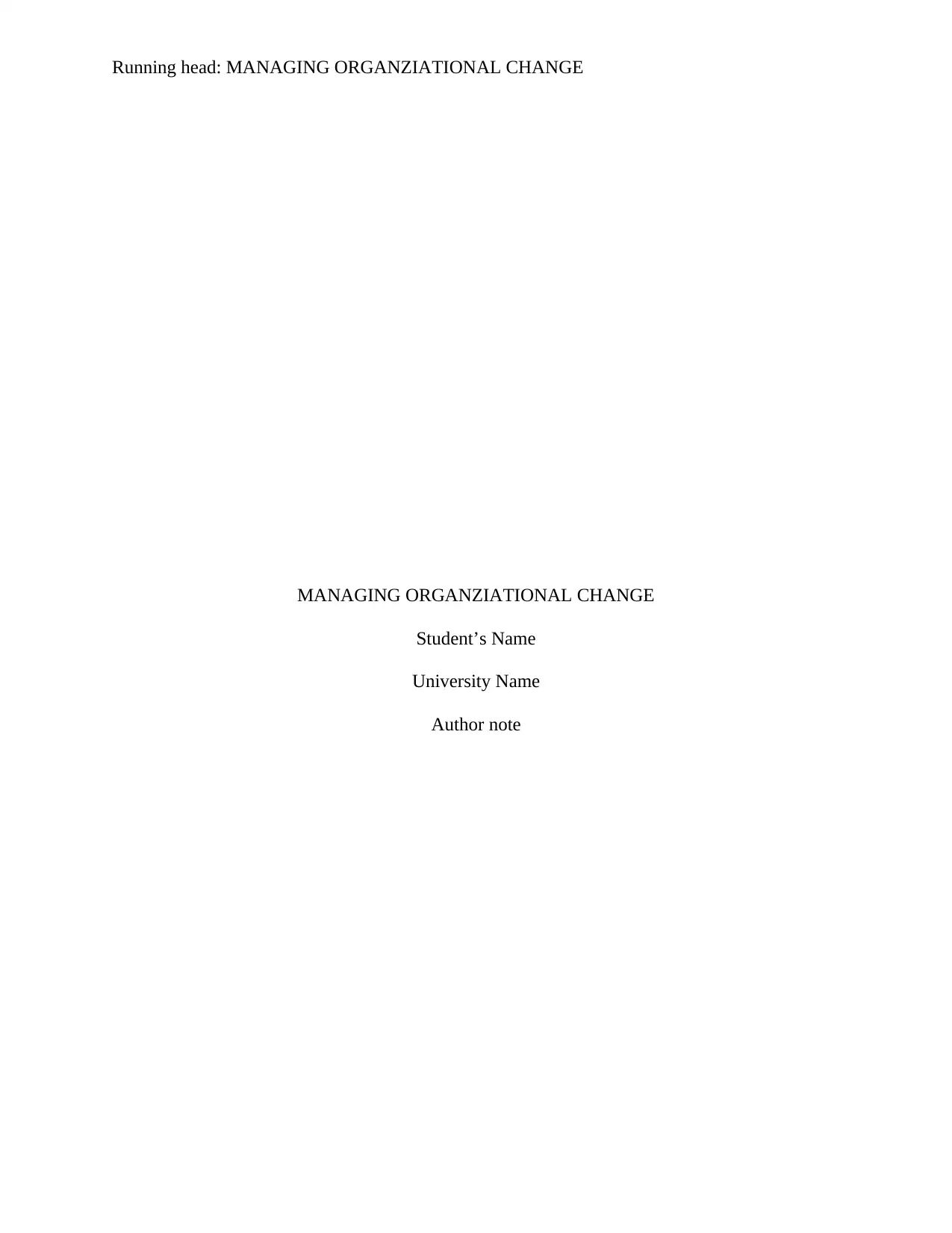
Running head: MANAGING ORGANZIATIONAL CHANGE
MANAGING ORGANZIATIONAL CHANGE
Student’s Name
University Name
Author note
MANAGING ORGANZIATIONAL CHANGE
Student’s Name
University Name
Author note
Paraphrase This Document
Need a fresh take? Get an instant paraphrase of this document with our AI Paraphraser
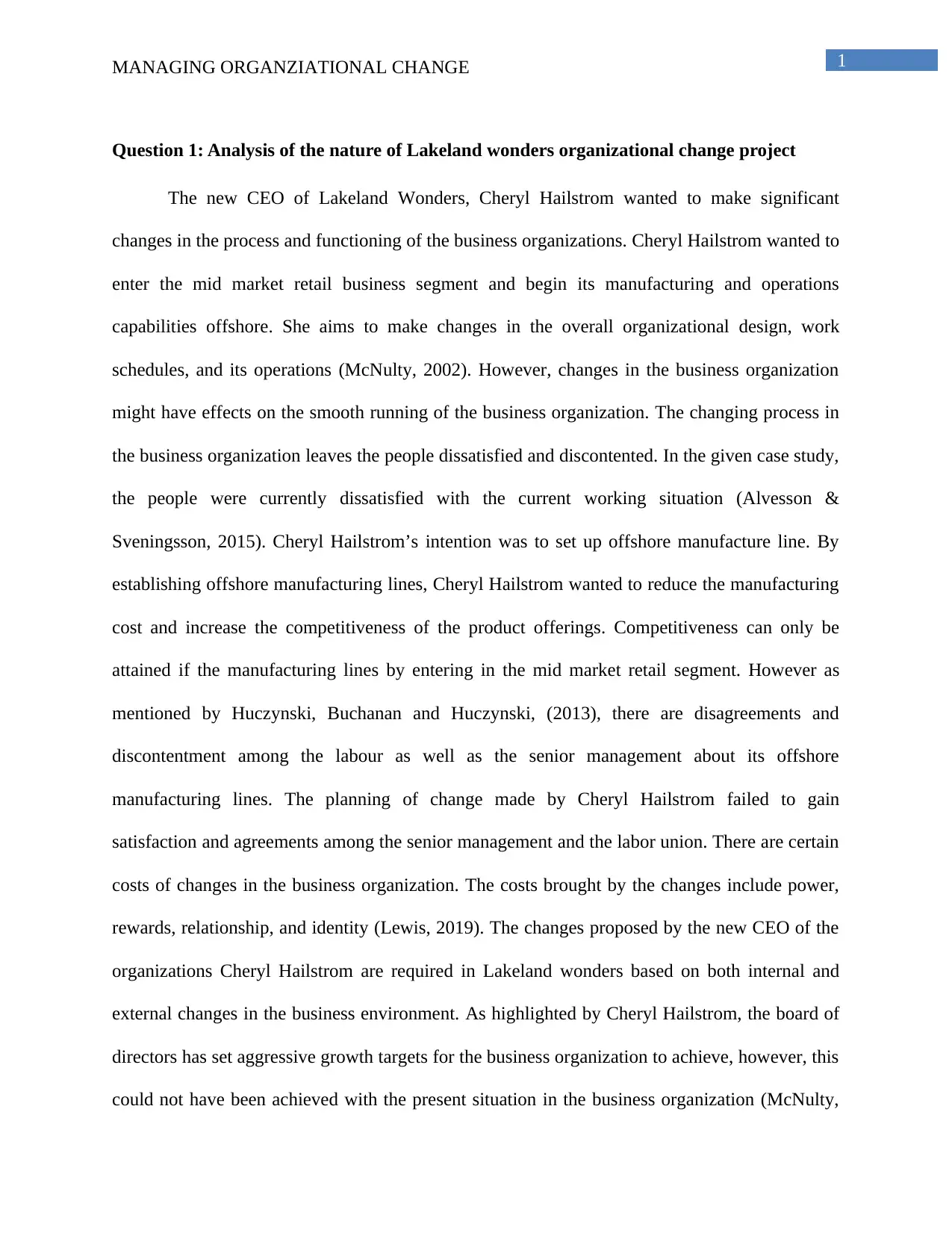
1MANAGING ORGANZIATIONAL CHANGE
Question 1: Analysis of the nature of Lakeland wonders organizational change project
The new CEO of Lakeland Wonders, Cheryl Hailstrom wanted to make significant
changes in the process and functioning of the business organizations. Cheryl Hailstrom wanted to
enter the mid market retail business segment and begin its manufacturing and operations
capabilities offshore. She aims to make changes in the overall organizational design, work
schedules, and its operations (McNulty, 2002). However, changes in the business organization
might have effects on the smooth running of the business organization. The changing process in
the business organization leaves the people dissatisfied and discontented. In the given case study,
the people were currently dissatisfied with the current working situation (Alvesson &
Sveningsson, 2015). Cheryl Hailstrom’s intention was to set up offshore manufacture line. By
establishing offshore manufacturing lines, Cheryl Hailstrom wanted to reduce the manufacturing
cost and increase the competitiveness of the product offerings. Competitiveness can only be
attained if the manufacturing lines by entering in the mid market retail segment. However as
mentioned by Huczynski, Buchanan and Huczynski, (2013), there are disagreements and
discontentment among the labour as well as the senior management about its offshore
manufacturing lines. The planning of change made by Cheryl Hailstrom failed to gain
satisfaction and agreements among the senior management and the labor union. There are certain
costs of changes in the business organization. The costs brought by the changes include power,
rewards, relationship, and identity (Lewis, 2019). The changes proposed by the new CEO of the
organizations Cheryl Hailstrom are required in Lakeland wonders based on both internal and
external changes in the business environment. As highlighted by Cheryl Hailstrom, the board of
directors has set aggressive growth targets for the business organization to achieve, however, this
could not have been achieved with the present situation in the business organization (McNulty,
Question 1: Analysis of the nature of Lakeland wonders organizational change project
The new CEO of Lakeland Wonders, Cheryl Hailstrom wanted to make significant
changes in the process and functioning of the business organizations. Cheryl Hailstrom wanted to
enter the mid market retail business segment and begin its manufacturing and operations
capabilities offshore. She aims to make changes in the overall organizational design, work
schedules, and its operations (McNulty, 2002). However, changes in the business organization
might have effects on the smooth running of the business organization. The changing process in
the business organization leaves the people dissatisfied and discontented. In the given case study,
the people were currently dissatisfied with the current working situation (Alvesson &
Sveningsson, 2015). Cheryl Hailstrom’s intention was to set up offshore manufacture line. By
establishing offshore manufacturing lines, Cheryl Hailstrom wanted to reduce the manufacturing
cost and increase the competitiveness of the product offerings. Competitiveness can only be
attained if the manufacturing lines by entering in the mid market retail segment. However as
mentioned by Huczynski, Buchanan and Huczynski, (2013), there are disagreements and
discontentment among the labour as well as the senior management about its offshore
manufacturing lines. The planning of change made by Cheryl Hailstrom failed to gain
satisfaction and agreements among the senior management and the labor union. There are certain
costs of changes in the business organization. The costs brought by the changes include power,
rewards, relationship, and identity (Lewis, 2019). The changes proposed by the new CEO of the
organizations Cheryl Hailstrom are required in Lakeland wonders based on both internal and
external changes in the business environment. As highlighted by Cheryl Hailstrom, the board of
directors has set aggressive growth targets for the business organization to achieve, however, this
could not have been achieved with the present situation in the business organization (McNulty,
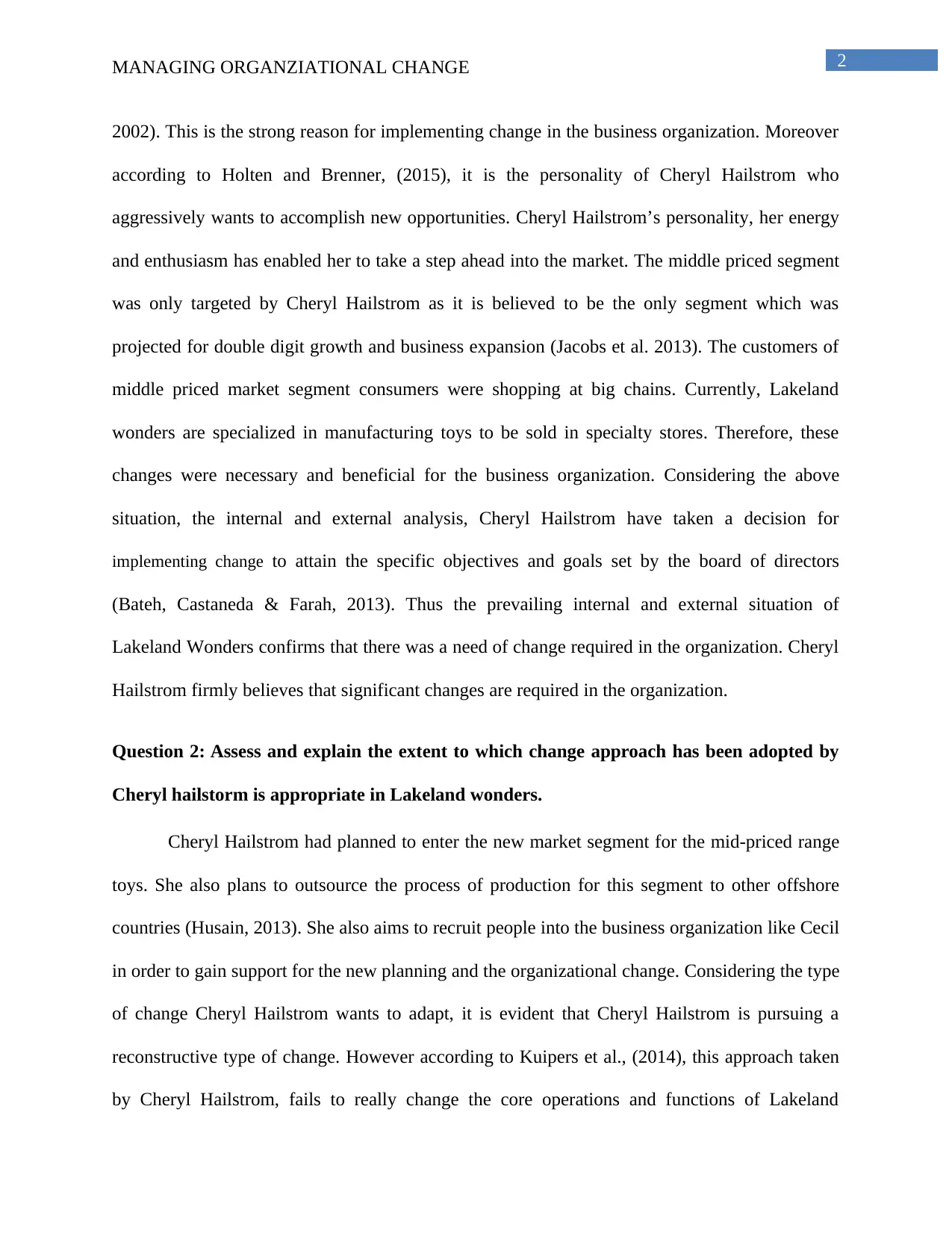
2MANAGING ORGANZIATIONAL CHANGE
2002). This is the strong reason for implementing change in the business organization. Moreover
according to Holten and Brenner, (2015), it is the personality of Cheryl Hailstrom who
aggressively wants to accomplish new opportunities. Cheryl Hailstrom’s personality, her energy
and enthusiasm has enabled her to take a step ahead into the market. The middle priced segment
was only targeted by Cheryl Hailstrom as it is believed to be the only segment which was
projected for double digit growth and business expansion (Jacobs et al. 2013). The customers of
middle priced market segment consumers were shopping at big chains. Currently, Lakeland
wonders are specialized in manufacturing toys to be sold in specialty stores. Therefore, these
changes were necessary and beneficial for the business organization. Considering the above
situation, the internal and external analysis, Cheryl Hailstrom have taken a decision for
implementing change to attain the specific objectives and goals set by the board of directors
(Bateh, Castaneda & Farah, 2013). Thus the prevailing internal and external situation of
Lakeland Wonders confirms that there was a need of change required in the organization. Cheryl
Hailstrom firmly believes that significant changes are required in the organization.
Question 2: Assess and explain the extent to which change approach has been adopted by
Cheryl hailstorm is appropriate in Lakeland wonders.
Cheryl Hailstrom had planned to enter the new market segment for the mid-priced range
toys. She also plans to outsource the process of production for this segment to other offshore
countries (Husain, 2013). She also aims to recruit people into the business organization like Cecil
in order to gain support for the new planning and the organizational change. Considering the type
of change Cheryl Hailstrom wants to adapt, it is evident that Cheryl Hailstrom is pursuing a
reconstructive type of change. However according to Kuipers et al., (2014), this approach taken
by Cheryl Hailstrom, fails to really change the core operations and functions of Lakeland
2002). This is the strong reason for implementing change in the business organization. Moreover
according to Holten and Brenner, (2015), it is the personality of Cheryl Hailstrom who
aggressively wants to accomplish new opportunities. Cheryl Hailstrom’s personality, her energy
and enthusiasm has enabled her to take a step ahead into the market. The middle priced segment
was only targeted by Cheryl Hailstrom as it is believed to be the only segment which was
projected for double digit growth and business expansion (Jacobs et al. 2013). The customers of
middle priced market segment consumers were shopping at big chains. Currently, Lakeland
wonders are specialized in manufacturing toys to be sold in specialty stores. Therefore, these
changes were necessary and beneficial for the business organization. Considering the above
situation, the internal and external analysis, Cheryl Hailstrom have taken a decision for
implementing change to attain the specific objectives and goals set by the board of directors
(Bateh, Castaneda & Farah, 2013). Thus the prevailing internal and external situation of
Lakeland Wonders confirms that there was a need of change required in the organization. Cheryl
Hailstrom firmly believes that significant changes are required in the organization.
Question 2: Assess and explain the extent to which change approach has been adopted by
Cheryl hailstorm is appropriate in Lakeland wonders.
Cheryl Hailstrom had planned to enter the new market segment for the mid-priced range
toys. She also plans to outsource the process of production for this segment to other offshore
countries (Husain, 2013). She also aims to recruit people into the business organization like Cecil
in order to gain support for the new planning and the organizational change. Considering the type
of change Cheryl Hailstrom wants to adapt, it is evident that Cheryl Hailstrom is pursuing a
reconstructive type of change. However according to Kuipers et al., (2014), this approach taken
by Cheryl Hailstrom, fails to really change the core operations and functions of Lakeland
⊘ This is a preview!⊘
Do you want full access?
Subscribe today to unlock all pages.

Trusted by 1+ million students worldwide
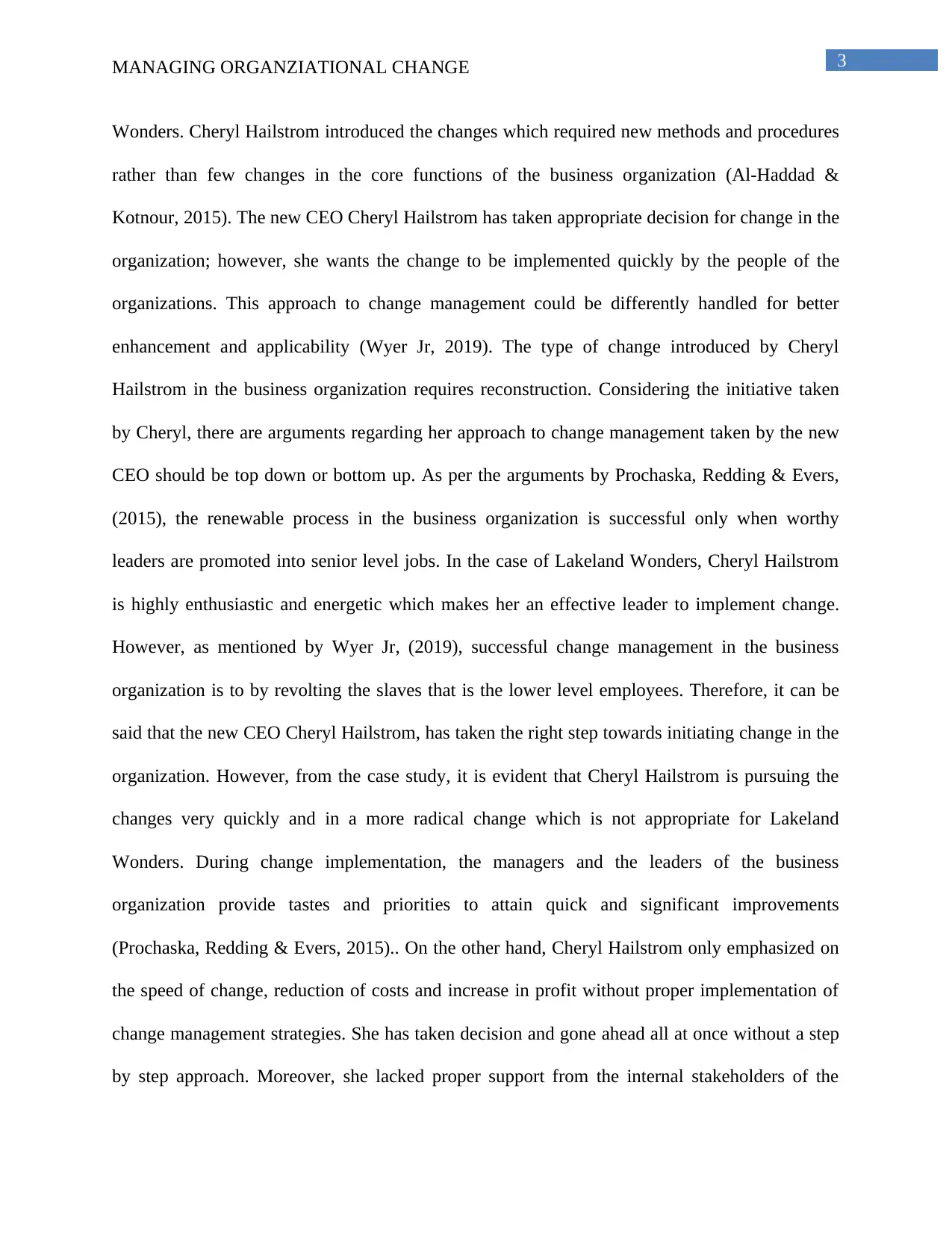
3MANAGING ORGANZIATIONAL CHANGE
Wonders. Cheryl Hailstrom introduced the changes which required new methods and procedures
rather than few changes in the core functions of the business organization (Al-Haddad &
Kotnour, 2015). The new CEO Cheryl Hailstrom has taken appropriate decision for change in the
organization; however, she wants the change to be implemented quickly by the people of the
organizations. This approach to change management could be differently handled for better
enhancement and applicability (Wyer Jr, 2019). The type of change introduced by Cheryl
Hailstrom in the business organization requires reconstruction. Considering the initiative taken
by Cheryl, there are arguments regarding her approach to change management taken by the new
CEO should be top down or bottom up. As per the arguments by Prochaska, Redding & Evers,
(2015), the renewable process in the business organization is successful only when worthy
leaders are promoted into senior level jobs. In the case of Lakeland Wonders, Cheryl Hailstrom
is highly enthusiastic and energetic which makes her an effective leader to implement change.
However, as mentioned by Wyer Jr, (2019), successful change management in the business
organization is to by revolting the slaves that is the lower level employees. Therefore, it can be
said that the new CEO Cheryl Hailstrom, has taken the right step towards initiating change in the
organization. However, from the case study, it is evident that Cheryl Hailstrom is pursuing the
changes very quickly and in a more radical change which is not appropriate for Lakeland
Wonders. During change implementation, the managers and the leaders of the business
organization provide tastes and priorities to attain quick and significant improvements
(Prochaska, Redding & Evers, 2015).. On the other hand, Cheryl Hailstrom only emphasized on
the speed of change, reduction of costs and increase in profit without proper implementation of
change management strategies. She has taken decision and gone ahead all at once without a step
by step approach. Moreover, she lacked proper support from the internal stakeholders of the
Wonders. Cheryl Hailstrom introduced the changes which required new methods and procedures
rather than few changes in the core functions of the business organization (Al-Haddad &
Kotnour, 2015). The new CEO Cheryl Hailstrom has taken appropriate decision for change in the
organization; however, she wants the change to be implemented quickly by the people of the
organizations. This approach to change management could be differently handled for better
enhancement and applicability (Wyer Jr, 2019). The type of change introduced by Cheryl
Hailstrom in the business organization requires reconstruction. Considering the initiative taken
by Cheryl, there are arguments regarding her approach to change management taken by the new
CEO should be top down or bottom up. As per the arguments by Prochaska, Redding & Evers,
(2015), the renewable process in the business organization is successful only when worthy
leaders are promoted into senior level jobs. In the case of Lakeland Wonders, Cheryl Hailstrom
is highly enthusiastic and energetic which makes her an effective leader to implement change.
However, as mentioned by Wyer Jr, (2019), successful change management in the business
organization is to by revolting the slaves that is the lower level employees. Therefore, it can be
said that the new CEO Cheryl Hailstrom, has taken the right step towards initiating change in the
organization. However, from the case study, it is evident that Cheryl Hailstrom is pursuing the
changes very quickly and in a more radical change which is not appropriate for Lakeland
Wonders. During change implementation, the managers and the leaders of the business
organization provide tastes and priorities to attain quick and significant improvements
(Prochaska, Redding & Evers, 2015).. On the other hand, Cheryl Hailstrom only emphasized on
the speed of change, reduction of costs and increase in profit without proper implementation of
change management strategies. She has taken decision and gone ahead all at once without a step
by step approach. Moreover, she lacked proper support from the internal stakeholders of the
Paraphrase This Document
Need a fresh take? Get an instant paraphrase of this document with our AI Paraphraser
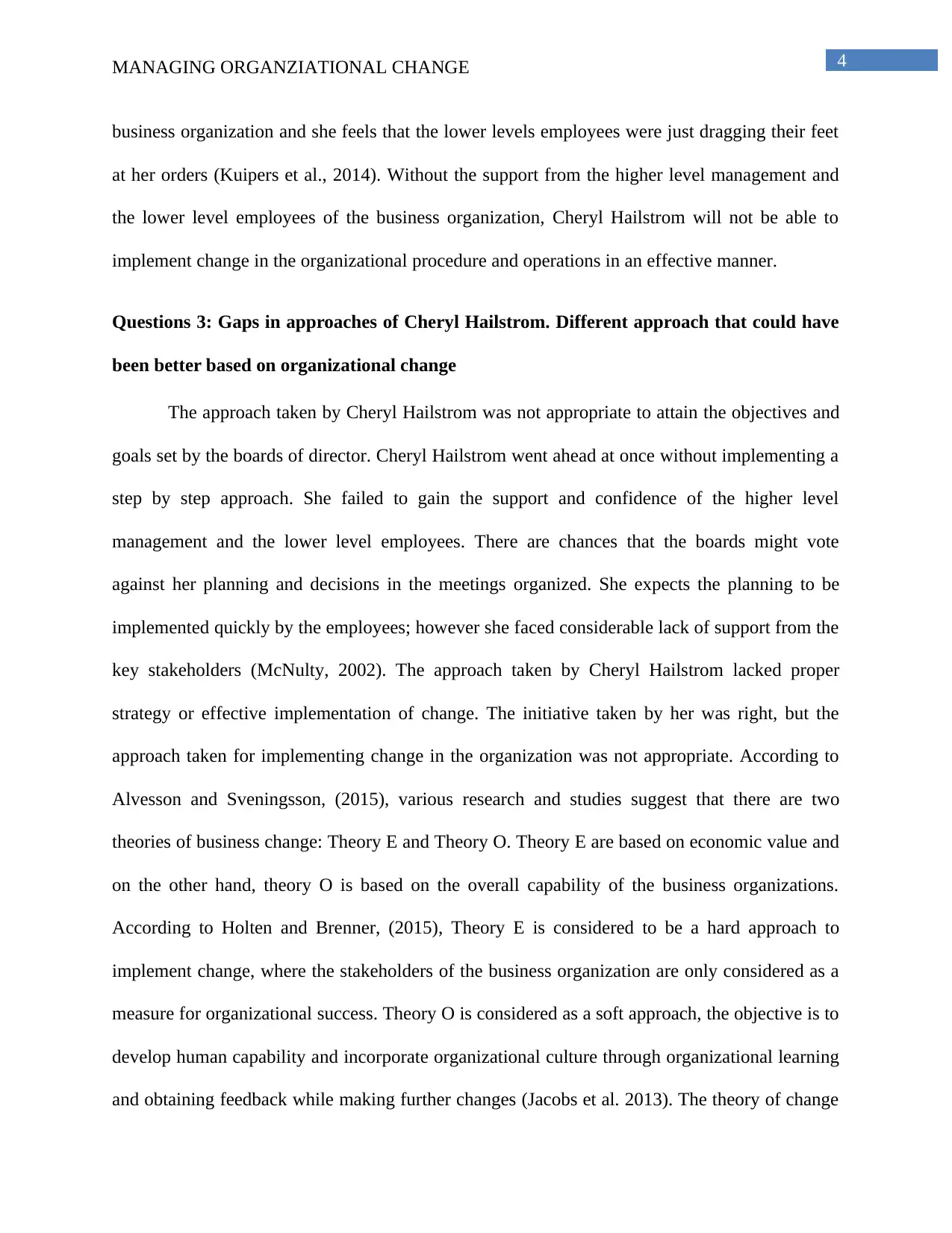
4MANAGING ORGANZIATIONAL CHANGE
business organization and she feels that the lower levels employees were just dragging their feet
at her orders (Kuipers et al., 2014). Without the support from the higher level management and
the lower level employees of the business organization, Cheryl Hailstrom will not be able to
implement change in the organizational procedure and operations in an effective manner.
Questions 3: Gaps in approaches of Cheryl Hailstrom. Different approach that could have
been better based on organizational change
The approach taken by Cheryl Hailstrom was not appropriate to attain the objectives and
goals set by the boards of director. Cheryl Hailstrom went ahead at once without implementing a
step by step approach. She failed to gain the support and confidence of the higher level
management and the lower level employees. There are chances that the boards might vote
against her planning and decisions in the meetings organized. She expects the planning to be
implemented quickly by the employees; however she faced considerable lack of support from the
key stakeholders (McNulty, 2002). The approach taken by Cheryl Hailstrom lacked proper
strategy or effective implementation of change. The initiative taken by her was right, but the
approach taken for implementing change in the organization was not appropriate. According to
Alvesson and Sveningsson, (2015), various research and studies suggest that there are two
theories of business change: Theory E and Theory O. Theory E are based on economic value and
on the other hand, theory O is based on the overall capability of the business organizations.
According to Holten and Brenner, (2015), Theory E is considered to be a hard approach to
implement change, where the stakeholders of the business organization are only considered as a
measure for organizational success. Theory O is considered as a soft approach, the objective is to
develop human capability and incorporate organizational culture through organizational learning
and obtaining feedback while making further changes (Jacobs et al. 2013). The theory of change
business organization and she feels that the lower levels employees were just dragging their feet
at her orders (Kuipers et al., 2014). Without the support from the higher level management and
the lower level employees of the business organization, Cheryl Hailstrom will not be able to
implement change in the organizational procedure and operations in an effective manner.
Questions 3: Gaps in approaches of Cheryl Hailstrom. Different approach that could have
been better based on organizational change
The approach taken by Cheryl Hailstrom was not appropriate to attain the objectives and
goals set by the boards of director. Cheryl Hailstrom went ahead at once without implementing a
step by step approach. She failed to gain the support and confidence of the higher level
management and the lower level employees. There are chances that the boards might vote
against her planning and decisions in the meetings organized. She expects the planning to be
implemented quickly by the employees; however she faced considerable lack of support from the
key stakeholders (McNulty, 2002). The approach taken by Cheryl Hailstrom lacked proper
strategy or effective implementation of change. The initiative taken by her was right, but the
approach taken for implementing change in the organization was not appropriate. According to
Alvesson and Sveningsson, (2015), various research and studies suggest that there are two
theories of business change: Theory E and Theory O. Theory E are based on economic value and
on the other hand, theory O is based on the overall capability of the business organizations.
According to Holten and Brenner, (2015), Theory E is considered to be a hard approach to
implement change, where the stakeholders of the business organization are only considered as a
measure for organizational success. Theory O is considered as a soft approach, the objective is to
develop human capability and incorporate organizational culture through organizational learning
and obtaining feedback while making further changes (Jacobs et al. 2013). The theory of change
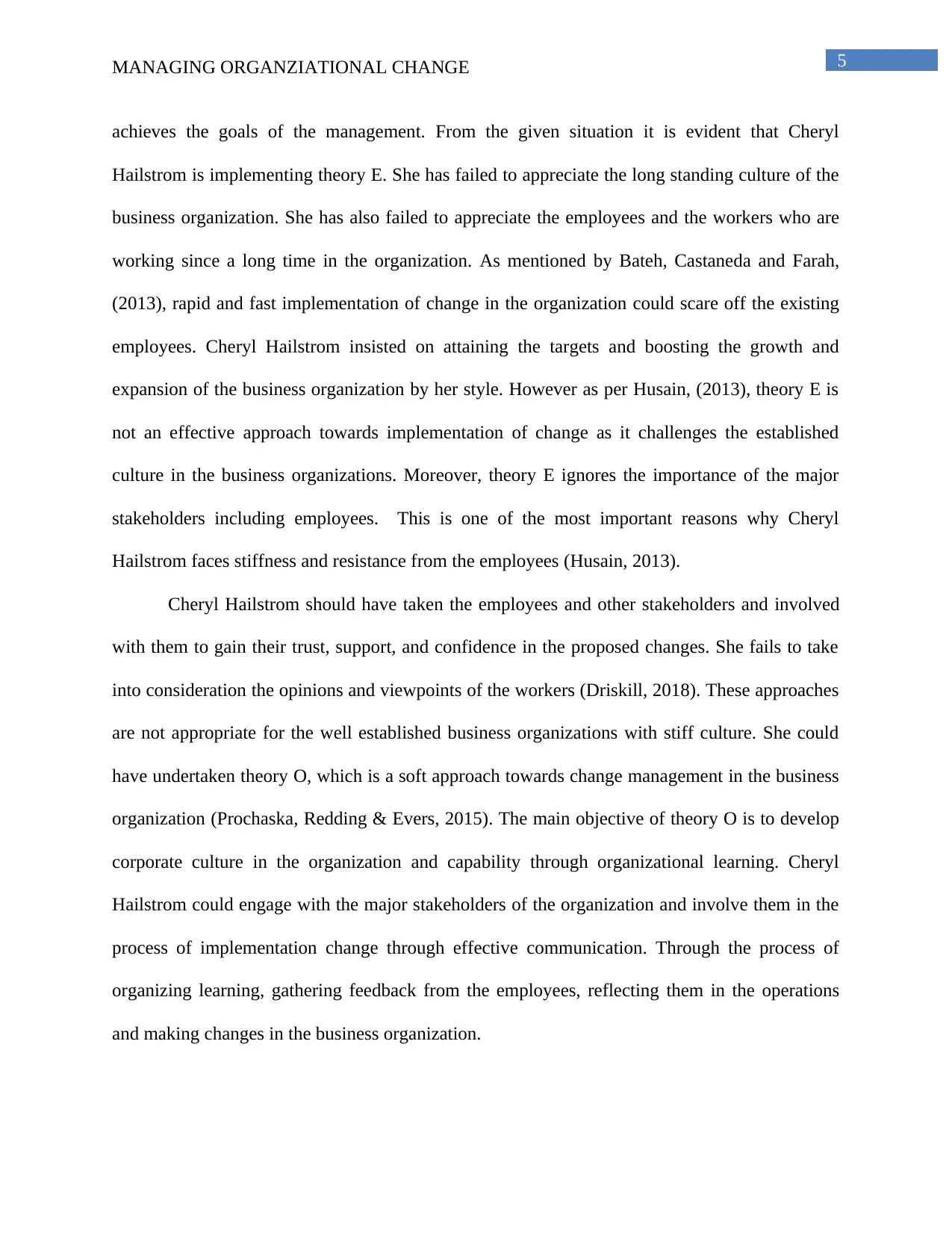
5MANAGING ORGANZIATIONAL CHANGE
achieves the goals of the management. From the given situation it is evident that Cheryl
Hailstrom is implementing theory E. She has failed to appreciate the long standing culture of the
business organization. She has also failed to appreciate the employees and the workers who are
working since a long time in the organization. As mentioned by Bateh, Castaneda and Farah,
(2013), rapid and fast implementation of change in the organization could scare off the existing
employees. Cheryl Hailstrom insisted on attaining the targets and boosting the growth and
expansion of the business organization by her style. However as per Husain, (2013), theory E is
not an effective approach towards implementation of change as it challenges the established
culture in the business organizations. Moreover, theory E ignores the importance of the major
stakeholders including employees. This is one of the most important reasons why Cheryl
Hailstrom faces stiffness and resistance from the employees (Husain, 2013).
Cheryl Hailstrom should have taken the employees and other stakeholders and involved
with them to gain their trust, support, and confidence in the proposed changes. She fails to take
into consideration the opinions and viewpoints of the workers (Driskill, 2018). These approaches
are not appropriate for the well established business organizations with stiff culture. She could
have undertaken theory O, which is a soft approach towards change management in the business
organization (Prochaska, Redding & Evers, 2015). The main objective of theory O is to develop
corporate culture in the organization and capability through organizational learning. Cheryl
Hailstrom could engage with the major stakeholders of the organization and involve them in the
process of implementation change through effective communication. Through the process of
organizing learning, gathering feedback from the employees, reflecting them in the operations
and making changes in the business organization.
achieves the goals of the management. From the given situation it is evident that Cheryl
Hailstrom is implementing theory E. She has failed to appreciate the long standing culture of the
business organization. She has also failed to appreciate the employees and the workers who are
working since a long time in the organization. As mentioned by Bateh, Castaneda and Farah,
(2013), rapid and fast implementation of change in the organization could scare off the existing
employees. Cheryl Hailstrom insisted on attaining the targets and boosting the growth and
expansion of the business organization by her style. However as per Husain, (2013), theory E is
not an effective approach towards implementation of change as it challenges the established
culture in the business organizations. Moreover, theory E ignores the importance of the major
stakeholders including employees. This is one of the most important reasons why Cheryl
Hailstrom faces stiffness and resistance from the employees (Husain, 2013).
Cheryl Hailstrom should have taken the employees and other stakeholders and involved
with them to gain their trust, support, and confidence in the proposed changes. She fails to take
into consideration the opinions and viewpoints of the workers (Driskill, 2018). These approaches
are not appropriate for the well established business organizations with stiff culture. She could
have undertaken theory O, which is a soft approach towards change management in the business
organization (Prochaska, Redding & Evers, 2015). The main objective of theory O is to develop
corporate culture in the organization and capability through organizational learning. Cheryl
Hailstrom could engage with the major stakeholders of the organization and involve them in the
process of implementation change through effective communication. Through the process of
organizing learning, gathering feedback from the employees, reflecting them in the operations
and making changes in the business organization.
⊘ This is a preview!⊘
Do you want full access?
Subscribe today to unlock all pages.

Trusted by 1+ million students worldwide
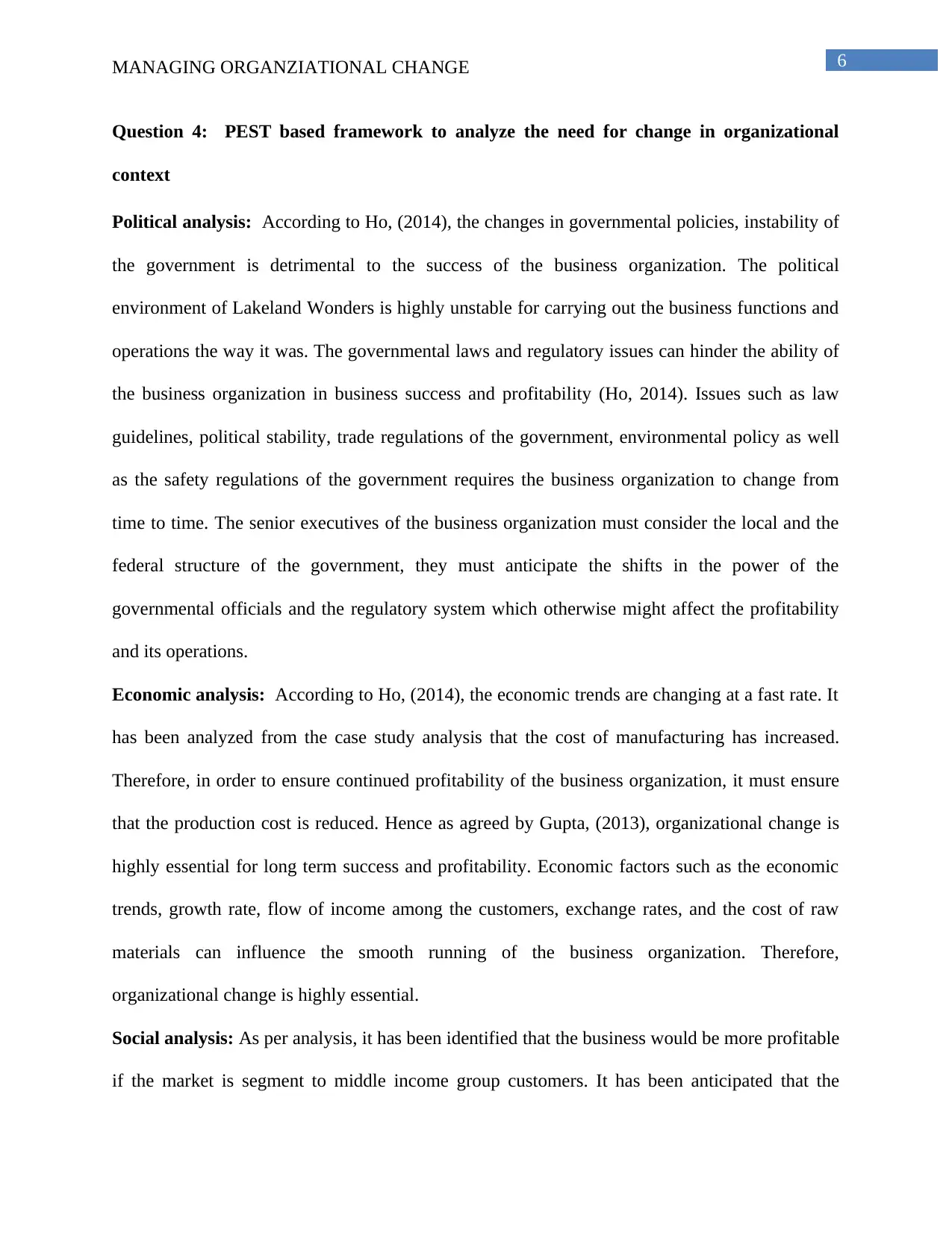
6MANAGING ORGANZIATIONAL CHANGE
Question 4: PEST based framework to analyze the need for change in organizational
context
Political analysis: According to Ho, (2014), the changes in governmental policies, instability of
the government is detrimental to the success of the business organization. The political
environment of Lakeland Wonders is highly unstable for carrying out the business functions and
operations the way it was. The governmental laws and regulatory issues can hinder the ability of
the business organization in business success and profitability (Ho, 2014). Issues such as law
guidelines, political stability, trade regulations of the government, environmental policy as well
as the safety regulations of the government requires the business organization to change from
time to time. The senior executives of the business organization must consider the local and the
federal structure of the government, they must anticipate the shifts in the power of the
governmental officials and the regulatory system which otherwise might affect the profitability
and its operations.
Economic analysis: According to Ho, (2014), the economic trends are changing at a fast rate. It
has been analyzed from the case study analysis that the cost of manufacturing has increased.
Therefore, in order to ensure continued profitability of the business organization, it must ensure
that the production cost is reduced. Hence as agreed by Gupta, (2013), organizational change is
highly essential for long term success and profitability. Economic factors such as the economic
trends, growth rate, flow of income among the customers, exchange rates, and the cost of raw
materials can influence the smooth running of the business organization. Therefore,
organizational change is highly essential.
Social analysis: As per analysis, it has been identified that the business would be more profitable
if the market is segment to middle income group customers. It has been anticipated that the
Question 4: PEST based framework to analyze the need for change in organizational
context
Political analysis: According to Ho, (2014), the changes in governmental policies, instability of
the government is detrimental to the success of the business organization. The political
environment of Lakeland Wonders is highly unstable for carrying out the business functions and
operations the way it was. The governmental laws and regulatory issues can hinder the ability of
the business organization in business success and profitability (Ho, 2014). Issues such as law
guidelines, political stability, trade regulations of the government, environmental policy as well
as the safety regulations of the government requires the business organization to change from
time to time. The senior executives of the business organization must consider the local and the
federal structure of the government, they must anticipate the shifts in the power of the
governmental officials and the regulatory system which otherwise might affect the profitability
and its operations.
Economic analysis: According to Ho, (2014), the economic trends are changing at a fast rate. It
has been analyzed from the case study analysis that the cost of manufacturing has increased.
Therefore, in order to ensure continued profitability of the business organization, it must ensure
that the production cost is reduced. Hence as agreed by Gupta, (2013), organizational change is
highly essential for long term success and profitability. Economic factors such as the economic
trends, growth rate, flow of income among the customers, exchange rates, and the cost of raw
materials can influence the smooth running of the business organization. Therefore,
organizational change is highly essential.
Social analysis: As per analysis, it has been identified that the business would be more profitable
if the market is segment to middle income group customers. It has been anticipated that the
Paraphrase This Document
Need a fresh take? Get an instant paraphrase of this document with our AI Paraphraser
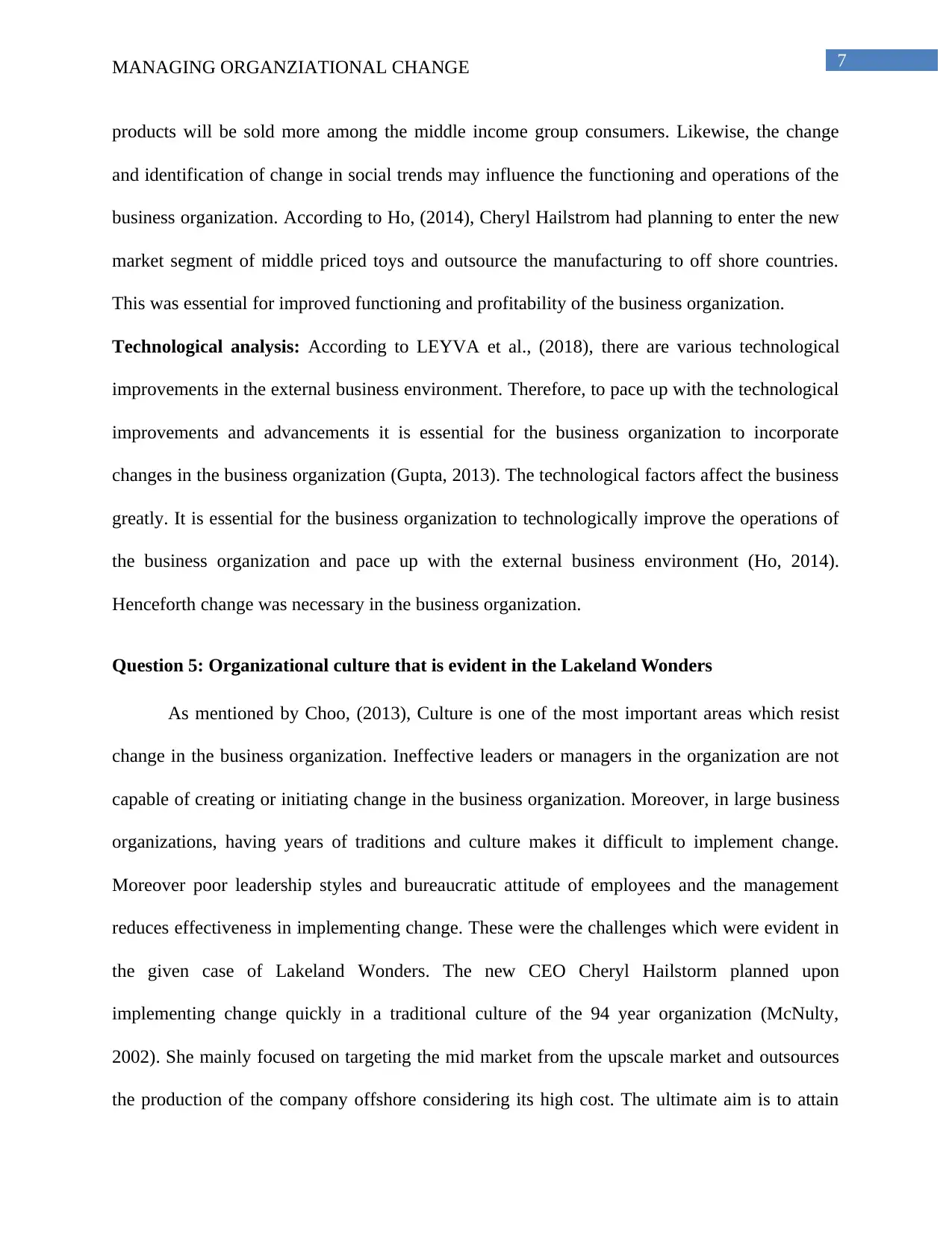
7MANAGING ORGANZIATIONAL CHANGE
products will be sold more among the middle income group consumers. Likewise, the change
and identification of change in social trends may influence the functioning and operations of the
business organization. According to Ho, (2014), Cheryl Hailstrom had planning to enter the new
market segment of middle priced toys and outsource the manufacturing to off shore countries.
This was essential for improved functioning and profitability of the business organization.
Technological analysis: According to LEYVA et al., (2018), there are various technological
improvements in the external business environment. Therefore, to pace up with the technological
improvements and advancements it is essential for the business organization to incorporate
changes in the business organization (Gupta, 2013). The technological factors affect the business
greatly. It is essential for the business organization to technologically improve the operations of
the business organization and pace up with the external business environment (Ho, 2014).
Henceforth change was necessary in the business organization.
Question 5: Organizational culture that is evident in the Lakeland Wonders
As mentioned by Choo, (2013), Culture is one of the most important areas which resist
change in the business organization. Ineffective leaders or managers in the organization are not
capable of creating or initiating change in the business organization. Moreover, in large business
organizations, having years of traditions and culture makes it difficult to implement change.
Moreover poor leadership styles and bureaucratic attitude of employees and the management
reduces effectiveness in implementing change. These were the challenges which were evident in
the given case of Lakeland Wonders. The new CEO Cheryl Hailstorm planned upon
implementing change quickly in a traditional culture of the 94 year organization (McNulty,
2002). She mainly focused on targeting the mid market from the upscale market and outsources
the production of the company offshore considering its high cost. The ultimate aim is to attain
products will be sold more among the middle income group consumers. Likewise, the change
and identification of change in social trends may influence the functioning and operations of the
business organization. According to Ho, (2014), Cheryl Hailstrom had planning to enter the new
market segment of middle priced toys and outsource the manufacturing to off shore countries.
This was essential for improved functioning and profitability of the business organization.
Technological analysis: According to LEYVA et al., (2018), there are various technological
improvements in the external business environment. Therefore, to pace up with the technological
improvements and advancements it is essential for the business organization to incorporate
changes in the business organization (Gupta, 2013). The technological factors affect the business
greatly. It is essential for the business organization to technologically improve the operations of
the business organization and pace up with the external business environment (Ho, 2014).
Henceforth change was necessary in the business organization.
Question 5: Organizational culture that is evident in the Lakeland Wonders
As mentioned by Choo, (2013), Culture is one of the most important areas which resist
change in the business organization. Ineffective leaders or managers in the organization are not
capable of creating or initiating change in the business organization. Moreover, in large business
organizations, having years of traditions and culture makes it difficult to implement change.
Moreover poor leadership styles and bureaucratic attitude of employees and the management
reduces effectiveness in implementing change. These were the challenges which were evident in
the given case of Lakeland Wonders. The new CEO Cheryl Hailstorm planned upon
implementing change quickly in a traditional culture of the 94 year organization (McNulty,
2002). She mainly focused on targeting the mid market from the upscale market and outsources
the production of the company offshore considering its high cost. The ultimate aim is to attain
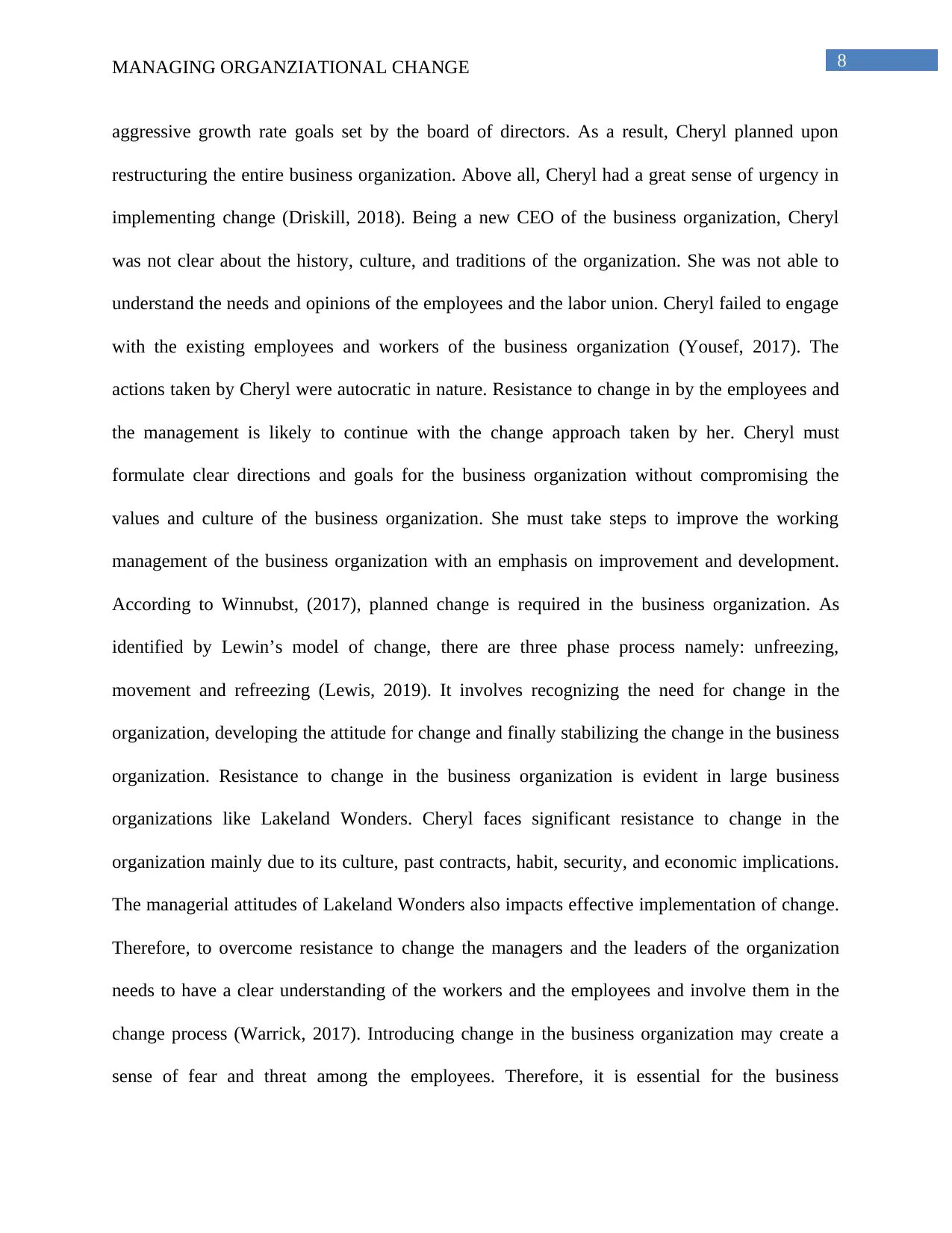
8MANAGING ORGANZIATIONAL CHANGE
aggressive growth rate goals set by the board of directors. As a result, Cheryl planned upon
restructuring the entire business organization. Above all, Cheryl had a great sense of urgency in
implementing change (Driskill, 2018). Being a new CEO of the business organization, Cheryl
was not clear about the history, culture, and traditions of the organization. She was not able to
understand the needs and opinions of the employees and the labor union. Cheryl failed to engage
with the existing employees and workers of the business organization (Yousef, 2017). The
actions taken by Cheryl were autocratic in nature. Resistance to change in by the employees and
the management is likely to continue with the change approach taken by her. Cheryl must
formulate clear directions and goals for the business organization without compromising the
values and culture of the business organization. She must take steps to improve the working
management of the business organization with an emphasis on improvement and development.
According to Winnubst, (2017), planned change is required in the business organization. As
identified by Lewin’s model of change, there are three phase process namely: unfreezing,
movement and refreezing (Lewis, 2019). It involves recognizing the need for change in the
organization, developing the attitude for change and finally stabilizing the change in the business
organization. Resistance to change in the business organization is evident in large business
organizations like Lakeland Wonders. Cheryl faces significant resistance to change in the
organization mainly due to its culture, past contracts, habit, security, and economic implications.
The managerial attitudes of Lakeland Wonders also impacts effective implementation of change.
Therefore, to overcome resistance to change the managers and the leaders of the organization
needs to have a clear understanding of the workers and the employees and involve them in the
change process (Warrick, 2017). Introducing change in the business organization may create a
sense of fear and threat among the employees. Therefore, it is essential for the business
aggressive growth rate goals set by the board of directors. As a result, Cheryl planned upon
restructuring the entire business organization. Above all, Cheryl had a great sense of urgency in
implementing change (Driskill, 2018). Being a new CEO of the business organization, Cheryl
was not clear about the history, culture, and traditions of the organization. She was not able to
understand the needs and opinions of the employees and the labor union. Cheryl failed to engage
with the existing employees and workers of the business organization (Yousef, 2017). The
actions taken by Cheryl were autocratic in nature. Resistance to change in by the employees and
the management is likely to continue with the change approach taken by her. Cheryl must
formulate clear directions and goals for the business organization without compromising the
values and culture of the business organization. She must take steps to improve the working
management of the business organization with an emphasis on improvement and development.
According to Winnubst, (2017), planned change is required in the business organization. As
identified by Lewin’s model of change, there are three phase process namely: unfreezing,
movement and refreezing (Lewis, 2019). It involves recognizing the need for change in the
organization, developing the attitude for change and finally stabilizing the change in the business
organization. Resistance to change in the business organization is evident in large business
organizations like Lakeland Wonders. Cheryl faces significant resistance to change in the
organization mainly due to its culture, past contracts, habit, security, and economic implications.
The managerial attitudes of Lakeland Wonders also impacts effective implementation of change.
Therefore, to overcome resistance to change the managers and the leaders of the organization
needs to have a clear understanding of the workers and the employees and involve them in the
change process (Warrick, 2017). Introducing change in the business organization may create a
sense of fear and threat among the employees. Therefore, it is essential for the business
⊘ This is a preview!⊘
Do you want full access?
Subscribe today to unlock all pages.

Trusted by 1+ million students worldwide
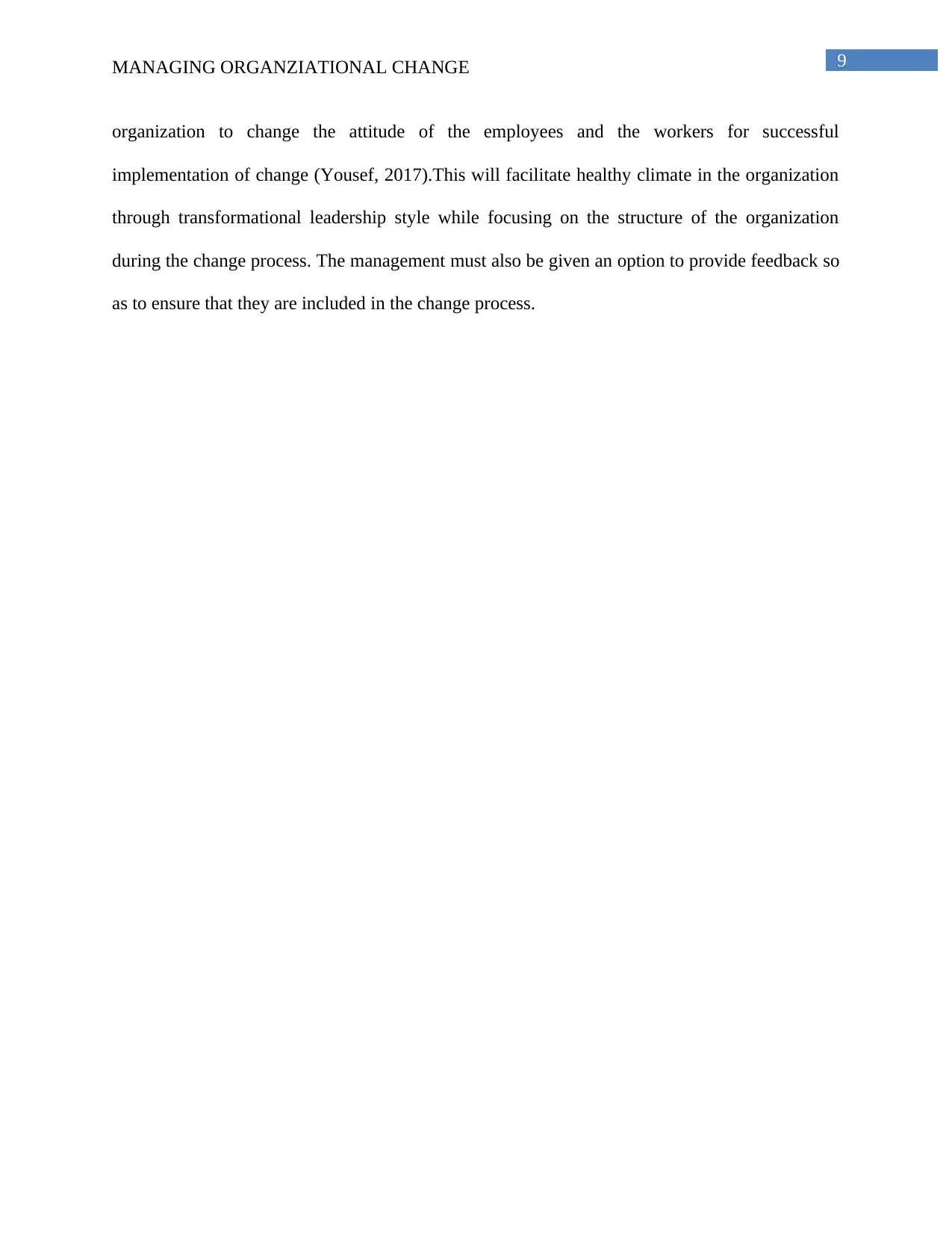
9MANAGING ORGANZIATIONAL CHANGE
organization to change the attitude of the employees and the workers for successful
implementation of change (Yousef, 2017).This will facilitate healthy climate in the organization
through transformational leadership style while focusing on the structure of the organization
during the change process. The management must also be given an option to provide feedback so
as to ensure that they are included in the change process.
organization to change the attitude of the employees and the workers for successful
implementation of change (Yousef, 2017).This will facilitate healthy climate in the organization
through transformational leadership style while focusing on the structure of the organization
during the change process. The management must also be given an option to provide feedback so
as to ensure that they are included in the change process.
Paraphrase This Document
Need a fresh take? Get an instant paraphrase of this document with our AI Paraphraser

10MANAGING ORGANZIATIONAL CHANGE
References
Al-Haddad, S., & Kotnour, T. (2015). Integrating the organizational change literature: a model
for successful change. Journal of Organizational Change Management, 28(2), 234-262.
Alvesson, M., & Sveningsson, S. (2015). Changing organizational culture: Cultural change
work in progress. Routledge.
Bateh, J., Castaneda, M. E., & Farah, J. E. (2013). Employee resistance to organizational
change. International Journal of Management & Information Systems (IJMIS), 17(2),
113-116.
Choo, C. W. (2013). Information culture and organizational effectiveness. International Journal
of Information Management, 33(5), 775-779.
Driskill, G. W. (2018). Organizational culture in action: A cultural analysis workbook.
Routledge.
Gupta, A. (2013). Environment & PEST analysis: an approach to the external business
environment. International Journal of Modern Social Sciences, 2(1), 34-43.
Ho, J. K. K. (2014). Formulation of a systemic PEST analysis for strategic analysis. European
academic research, 2(5), 6478-6492.
Holten, A. L., & Brenner, S. O. (2015). Leadership style and the process of organizational
change. Leadership & Organization Development Journal, 36(1), 2-16.
Huczynski, A., Buchanan, D. A., & Huczynski, A. A. (2013). Organizational behaviour (p. 82).
London: Pearson.
Husain, Z. (2013). Effective communication brings successful organizational change. The
Business & Management Review, 3(2), 43.
References
Al-Haddad, S., & Kotnour, T. (2015). Integrating the organizational change literature: a model
for successful change. Journal of Organizational Change Management, 28(2), 234-262.
Alvesson, M., & Sveningsson, S. (2015). Changing organizational culture: Cultural change
work in progress. Routledge.
Bateh, J., Castaneda, M. E., & Farah, J. E. (2013). Employee resistance to organizational
change. International Journal of Management & Information Systems (IJMIS), 17(2),
113-116.
Choo, C. W. (2013). Information culture and organizational effectiveness. International Journal
of Information Management, 33(5), 775-779.
Driskill, G. W. (2018). Organizational culture in action: A cultural analysis workbook.
Routledge.
Gupta, A. (2013). Environment & PEST analysis: an approach to the external business
environment. International Journal of Modern Social Sciences, 2(1), 34-43.
Ho, J. K. K. (2014). Formulation of a systemic PEST analysis for strategic analysis. European
academic research, 2(5), 6478-6492.
Holten, A. L., & Brenner, S. O. (2015). Leadership style and the process of organizational
change. Leadership & Organization Development Journal, 36(1), 2-16.
Huczynski, A., Buchanan, D. A., & Huczynski, A. A. (2013). Organizational behaviour (p. 82).
London: Pearson.
Husain, Z. (2013). Effective communication brings successful organizational change. The
Business & Management Review, 3(2), 43.
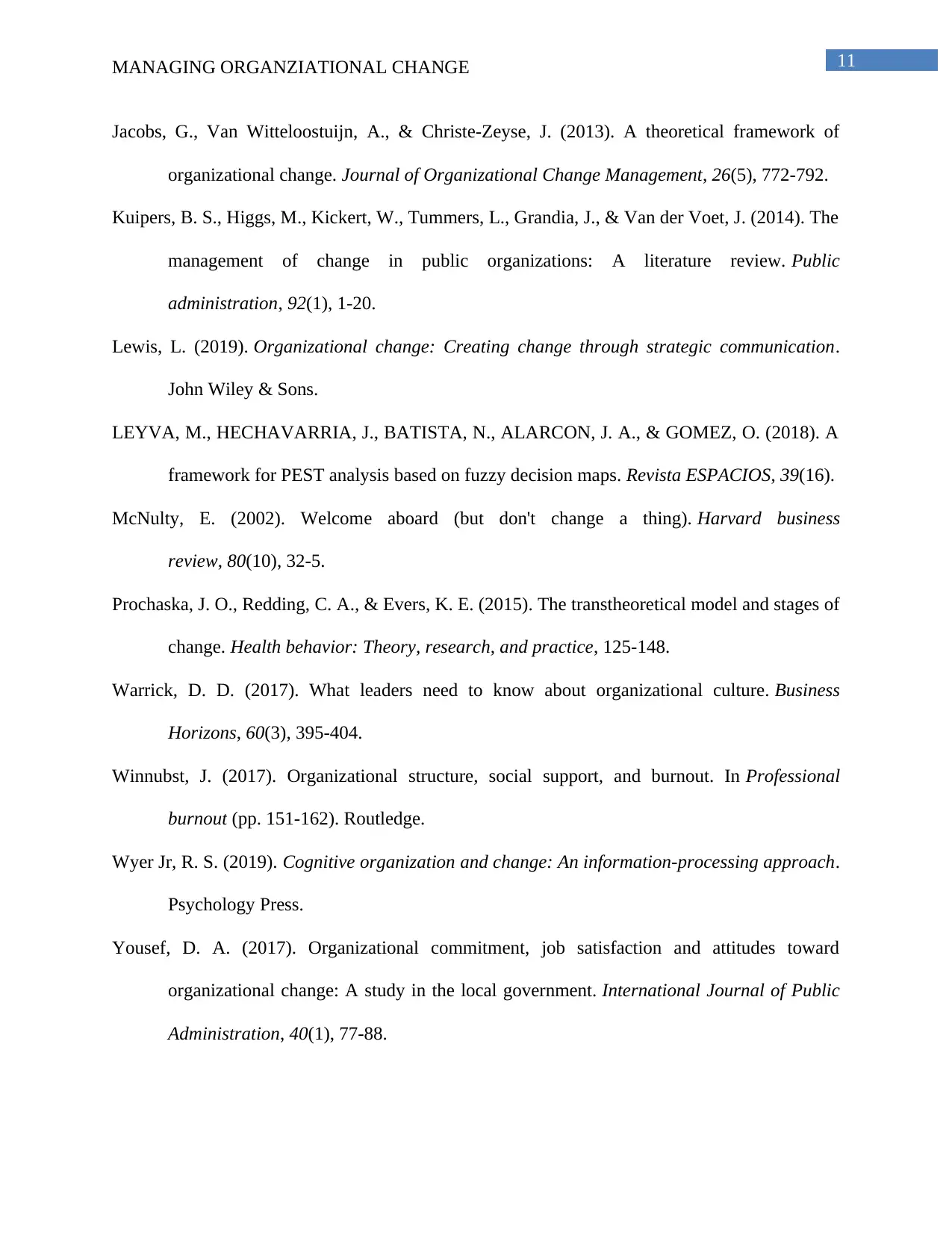
11MANAGING ORGANZIATIONAL CHANGE
Jacobs, G., Van Witteloostuijn, A., & Christe-Zeyse, J. (2013). A theoretical framework of
organizational change. Journal of Organizational Change Management, 26(5), 772-792.
Kuipers, B. S., Higgs, M., Kickert, W., Tummers, L., Grandia, J., & Van der Voet, J. (2014). The
management of change in public organizations: A literature review. Public
administration, 92(1), 1-20.
Lewis, L. (2019). Organizational change: Creating change through strategic communication.
John Wiley & Sons.
LEYVA, M., HECHAVARRIA, J., BATISTA, N., ALARCON, J. A., & GOMEZ, O. (2018). A
framework for PEST analysis based on fuzzy decision maps. Revista ESPACIOS, 39(16).
McNulty, E. (2002). Welcome aboard (but don't change a thing). Harvard business
review, 80(10), 32-5.
Prochaska, J. O., Redding, C. A., & Evers, K. E. (2015). The transtheoretical model and stages of
change. Health behavior: Theory, research, and practice, 125-148.
Warrick, D. D. (2017). What leaders need to know about organizational culture. Business
Horizons, 60(3), 395-404.
Winnubst, J. (2017). Organizational structure, social support, and burnout. In Professional
burnout (pp. 151-162). Routledge.
Wyer Jr, R. S. (2019). Cognitive organization and change: An information-processing approach.
Psychology Press.
Yousef, D. A. (2017). Organizational commitment, job satisfaction and attitudes toward
organizational change: A study in the local government. International Journal of Public
Administration, 40(1), 77-88.
Jacobs, G., Van Witteloostuijn, A., & Christe-Zeyse, J. (2013). A theoretical framework of
organizational change. Journal of Organizational Change Management, 26(5), 772-792.
Kuipers, B. S., Higgs, M., Kickert, W., Tummers, L., Grandia, J., & Van der Voet, J. (2014). The
management of change in public organizations: A literature review. Public
administration, 92(1), 1-20.
Lewis, L. (2019). Organizational change: Creating change through strategic communication.
John Wiley & Sons.
LEYVA, M., HECHAVARRIA, J., BATISTA, N., ALARCON, J. A., & GOMEZ, O. (2018). A
framework for PEST analysis based on fuzzy decision maps. Revista ESPACIOS, 39(16).
McNulty, E. (2002). Welcome aboard (but don't change a thing). Harvard business
review, 80(10), 32-5.
Prochaska, J. O., Redding, C. A., & Evers, K. E. (2015). The transtheoretical model and stages of
change. Health behavior: Theory, research, and practice, 125-148.
Warrick, D. D. (2017). What leaders need to know about organizational culture. Business
Horizons, 60(3), 395-404.
Winnubst, J. (2017). Organizational structure, social support, and burnout. In Professional
burnout (pp. 151-162). Routledge.
Wyer Jr, R. S. (2019). Cognitive organization and change: An information-processing approach.
Psychology Press.
Yousef, D. A. (2017). Organizational commitment, job satisfaction and attitudes toward
organizational change: A study in the local government. International Journal of Public
Administration, 40(1), 77-88.
⊘ This is a preview!⊘
Do you want full access?
Subscribe today to unlock all pages.

Trusted by 1+ million students worldwide
1 out of 12
Related Documents
Your All-in-One AI-Powered Toolkit for Academic Success.
+13062052269
info@desklib.com
Available 24*7 on WhatsApp / Email
![[object Object]](/_next/static/media/star-bottom.7253800d.svg)
Unlock your academic potential
Copyright © 2020–2025 A2Z Services. All Rights Reserved. Developed and managed by ZUCOL.





